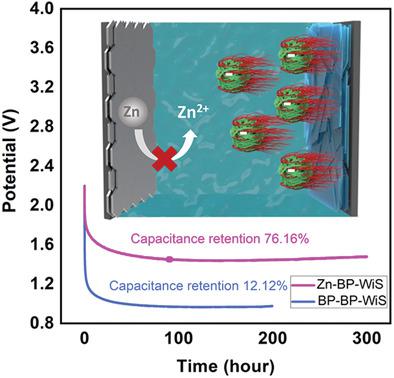当前位置:
X-MOL 学术
›
Adv. Energy Mater.
›
论文详情
Our official English website, www.x-mol.net, welcomes your
feedback! (Note: you will need to create a separate account there.)
Phosphorene as Cathode Material for High‐Voltage, Anti‐Self‐Discharge Zinc Ion Hybrid Capacitors
Advanced Energy Materials ( IF 24.4 ) Pub Date : 2020-05-07 , DOI: 10.1002/aenm.202001024 Zhaodong Huang 1 , Ao Chen 1 , Funian Mo 1 , Guojin Liang 1 , Xinliang Li 1 , Qi Yang 1 , Ying Guo 1 , Ze Chen 1 , Qing Li 1 , Binbin Dong 2 , Chunyi Zhi 1, 3
Advanced Energy Materials ( IF 24.4 ) Pub Date : 2020-05-07 , DOI: 10.1002/aenm.202001024 Zhaodong Huang 1 , Ao Chen 1 , Funian Mo 1 , Guojin Liang 1 , Xinliang Li 1 , Qi Yang 1 , Ying Guo 1 , Ze Chen 1 , Qing Li 1 , Binbin Dong 2 , Chunyi Zhi 1, 3
Affiliation

|
Output voltage and self‐discharge rate are two important performance indices for supercapacitors, which have long been overlooked, though these play a very significant role in their practical application. Here, a zinc anode is used to construct a zinc ion hybrid capacitor. Expanded operating voltage of the hybrid capacitor is obtained with novel electrolytes. In addition, significantly improved anti‐self‐discharge ability is achieved. The phosphorene‐based zinc ion capacitor exploiting a “water in salt” electrolyte with a working potential can reach 2.2 V, delivering 214.3 F g−1 after 5000 cycles. The operating voltage is further extended to 2.5 V through the use of an organic solvent as the electrolyte; the solvent is prepared by adding 0.2 m ZnCl2 into the tetraethylammonium tetrafluoroborate in propylene carbonate (Et4NBF4/PC) solvent, and it exhibits 105.9 F g−1 even after 9500 cycles. More importantly, the phosphorene‐based capacitors possess excellent anti‐self‐discharge performance. The capacitors retain 76.16% of capacitance after resting for 300 h. The practical application of the zinc ion capacitor is demonstrated through a flexible paper‐based printed microcapacitor. It is believed that the developed zinc ion capacitor can effectively resolve the severe self‐discharge problem of supercapacitors. Moreover, high‐voltage zinc ion capacitors provide more opportunities for the application of supercapacitors.
中文翻译:

磷用作高压,抗自放电锌离子混合电容器的阴极材料
输出电压和自放电率是超级电容器的两个重要性能指标,尽管它们在实际应用中起着非常重要的作用,但它们长期以来一直被忽略。这里,锌阳极用于构造锌离子混合电容器。用新型电解质可获得混合电容器的扩展工作电压。此外,大大提高了抗自放电能力。基于磷的锌离子电容器利用工作电压为“盐中的水”的电解质可达到2.2 V,在5000次循环后可提供214.3 F g -1的电荷。通过使用有机溶剂作为电解质,工作电压可进一步扩展至2.5V。通过添加0.2 m ZnCl 2来制备溶剂进入碳酸亚丙酯(Et 4 NBF 4 / PC)溶剂中的四氟硼酸四乙铵,即使经过9500次循环,它仍显示105.9 F g -1。更重要的是,基于磷的电容器具有出色的抗自放电性能。静置300小时后,电容器保留76.16%的电容。锌离子电容器的实际应用通过纸质柔性印刷微型电容器得到了证明。可以相信,开发的锌离子电容器可以有效解决超级电容器严重的自放电问题。此外,高压锌离子电容器为超级电容器的应用提供了更多机会。
更新日期:2020-06-23
中文翻译:

磷用作高压,抗自放电锌离子混合电容器的阴极材料
输出电压和自放电率是超级电容器的两个重要性能指标,尽管它们在实际应用中起着非常重要的作用,但它们长期以来一直被忽略。这里,锌阳极用于构造锌离子混合电容器。用新型电解质可获得混合电容器的扩展工作电压。此外,大大提高了抗自放电能力。基于磷的锌离子电容器利用工作电压为“盐中的水”的电解质可达到2.2 V,在5000次循环后可提供214.3 F g -1的电荷。通过使用有机溶剂作为电解质,工作电压可进一步扩展至2.5V。通过添加0.2 m ZnCl 2来制备溶剂进入碳酸亚丙酯(Et 4 NBF 4 / PC)溶剂中的四氟硼酸四乙铵,即使经过9500次循环,它仍显示105.9 F g -1。更重要的是,基于磷的电容器具有出色的抗自放电性能。静置300小时后,电容器保留76.16%的电容。锌离子电容器的实际应用通过纸质柔性印刷微型电容器得到了证明。可以相信,开发的锌离子电容器可以有效解决超级电容器严重的自放电问题。此外,高压锌离子电容器为超级电容器的应用提供了更多机会。











































 京公网安备 11010802027423号
京公网安备 11010802027423号